Weather
Watch Jeff Andresen’s weather update.
For the past seven days, temperatures were 2-4 degrees Fahrenheit below-normal with a large swath of heavy rain of 2 inches or so falling in the middle lower last Thursday, with over 4 inches in the heaviest spots. Drought conditions have definitely improved with the exception of northwest Michigan, which is drier. Degree days (base 50 F) are near-normal.
The forecast calls for:
- Precipitation totals of 0.25-0.75 inches are forecast for the coming week, with totals higher to the southeast.
- Fair and warmer Wednesday. Increasing clouds north.
- Showers and thunderstorms developing north Wednesday evening and spreading south during the day Thursday. Some strong storms possible southeast.
- Mostly fair and dry Friday and Saturday. Showers and thundershowers possible Sunday and Monday.
- High temperatures from the 70s north to low and mid-80s Wednesday and Thursday, cooling to the 70s to near 80 Friday and Saturday.
- Low temperatures generally from the 50s north to low 60s south.
- Medium range outlooks call for warmer than normal mean temperatures and near to above below normal precipitation totals.
Weed of the week
White campion (Silene latifolia) is a biennial broadleaf weed of the carnation family found across most of Michigan. It can be identified by its hairy leaves/stems, white flowers made up of v-shaped petals, and inflated, “balloon-like” calyx supporting the flowers. White campion typically overwinters as a rosette and sets seed the following spring. This weed is mostly problematic in no-till production systems but can also cause trouble in vegetable fields, particularly in the muck soils of west Michigan. Spartan 4F (sulfentrazone) is considered to have good pre-emergent activity, but is labeled for only a limited number of specialty crops, such as tomatoes, cabbage, and strawberries. Besides that, herbicides like glyphosate and dicamba provide good post-emergent control, so rotating to field crops where you have more herbicide options can help reduce weed pressure in years when you rotate back to vegetables.
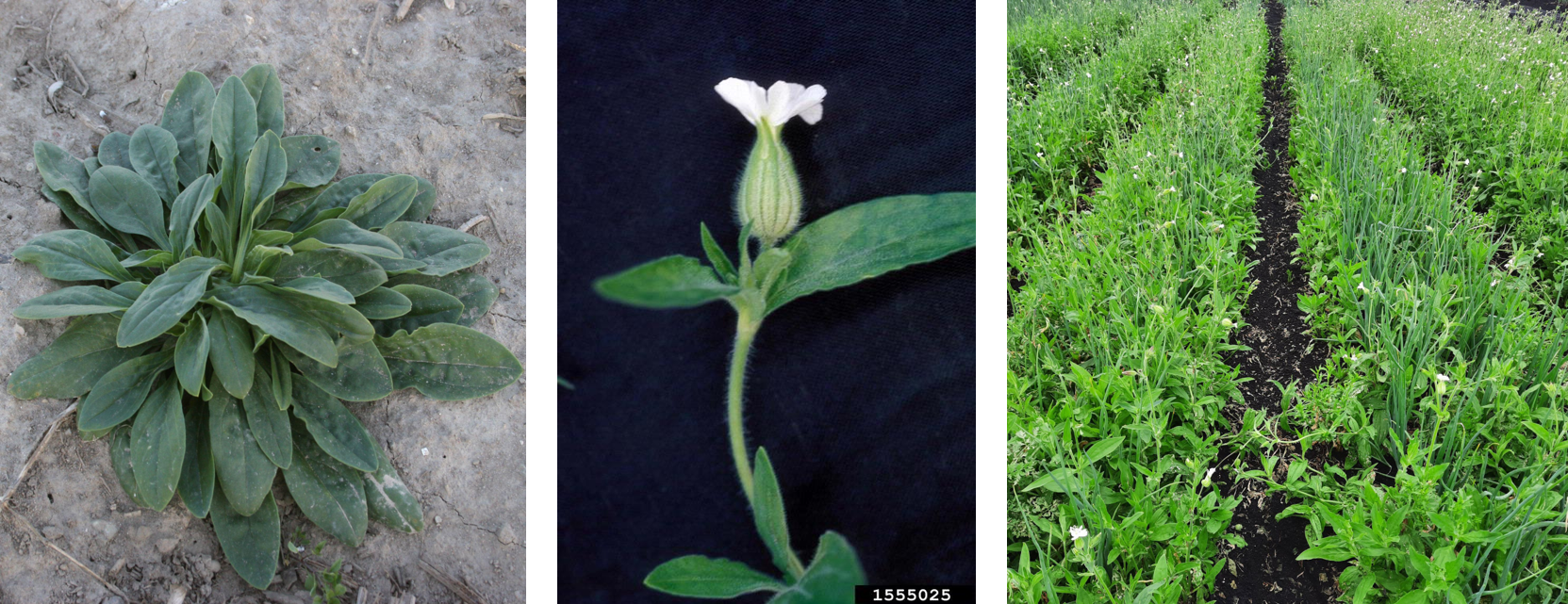
2023 MSU Extension Southeast Michigan Farmer Survey
MSU Extension is pleased to announce our 2023 Southeast Michigan Farmer Needs Assessment Survey. This survey will gather information about your farm and your potential interest in learning more about various farm-related topics. The information gathered will inform future programs and educational opportunities offered by MSU Extension educators for agricultural producers in southeast Michigan. This survey will take approximately 10 minutes to complete and is accessible at the link below:
Feel free to share the survey link with other growers. We welcome any participation in the survey in order to help Michigan State University Extension better serve its communities.
Rely herbicide label update
Sushila Chaudhari, MSU Extension vegetable weed control specialist, has provided the following update on a label change for the herbicide Rely 280 (glufosinate).
The U.S. Environmental Protection Agency (EPA) has approved a supplemental label for Rely 280 herbicide to help control several annual grasses and broadleaves in cantaloupe, cucumber, summer squash, watermelon, tomato and peppers (bell and non-bell). The Rely 280 label is good through Dec. 1, 2025. In plastic mulch systems, Rely 280 may be applied prior to transplanting, to row middles after planting using a hooded sprayer, or both. In tomato and peppers, Rely 280 may be applied as pre-plant burndown prior to transplanting in a bare soil production system. There is a wait-to-plant interval ranging from two to 21 days (varies with respect to crop, application timing and amount of precipitation after application). Apply up to three times per year but do not exceed a total amount of 87 fluid ounces per acre of Rely 280 per year from sequential applications. Allow a minimum of 14 days between sequential applications. Copies of the Rely 280 supplemental labels will be available from BASF technical service representatives.
QuickBooks survey
QuickBooks is one of the most widely used financial software packages for farm financial records. It is a powerful tool but using it effectively for farm businesses can be confusing. MSU Extension is partnering with the University of Wisconsin and University of Nebraska to develop educational resources for using QuickBooks for farm records effectively and efficiently. It would be greatly appreciated if you would complete a short survey that will help us better understand what is desired for QuickBooks educational programming.
Crop updates
Asparagus
For purple spot, between nine and 12 disease severity values accumulated July 11-17 at four sensors MSU Extension is monitoring. Fungicide applications are recommended once 15 disease severity values accumulate since the last application. Purple spot may be more advanced in situations where newly established asparagus fields were not harvested for the entire season.
Did you have a bad rust epidemic last year? If so, inoculum will be present. Past experience has shown it is important to protect against rust before epidemics occur. Protectants will provide some help. Otherwise, tebuconazole is the main rust specific material, but keep in mind it will not cure existing outbreaks. Back action is limited to reducing infections that are less than 48 hours old (i.e., infections that are not even visible). Three applications at 4-6 fluid ounces per acre (3.6 F formulation) at 14-day intervals are allowed per year.
To scout for rust, look for blistery orange lesions on the side and secondary branches of stems. Young fields, those with problems last year, and those near to problem fields are most at risk. The exact weather conditions that favor rust development are not known.
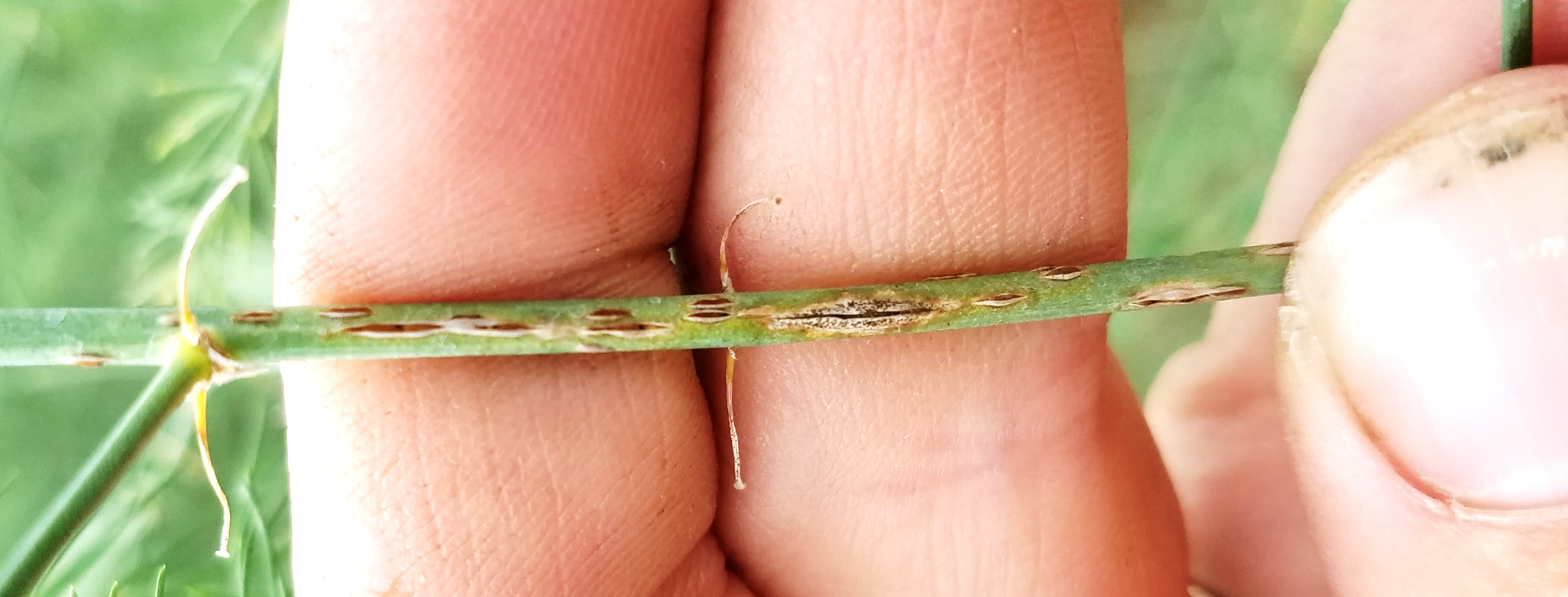
Japanese beetles continue to be present along field edges. Carbaryl and acetamiprid can provide control.
Carrots and celery
Celery harvest is underway with some farms reporting excellent quality. Scouts report that variegated cutworm is being caught in significant numbers. Overall aster leafhopper numbers have not been astronomical except for higher numbers in specific fields. Aphids have been present but are under control.
For carrots, it can be important to use highly effective fungicides such as Merivon or the Luna materials early in a foliar disease program, especially when disease symptoms are present and the weather favorable for disease. These locally systemic fungicides can be alternated with chlorothalonil, especially when spray programs begin prior to disease development or at just a trace of symptoms. The TOM-CAST system (disease severity threshold of 15) has been successfully implemented for use on Alternaria on carrots to time spray intervals once the program has been initiated.
The MSU Hausbeck pathology lab is interested in collecting carrot foliage and stems with symptoms of Alternaria blight. While Alternaria dauci is the pathogen primarily associated with foliar blighting, Alternaria radicina has become a pathogen of concern. Alternaria radicina may cause leaf blighting similar to Alternaria dauci but also causes black rot disease of the carrot root. Alternaria radicina has been found in Michigan carrot fields and further information is needed to understand the extent of the disease and develop a strategy to limit damage.
Cole crops and leafy greens
A steady supply of heading and cut-leaf greens are going to market. Cauliflower is a crop that is full of surprises. Much like sweet corn, caterpillars can hide in the marketable part. The main market calls for white cauliflower, which is blocked from sunlight through tying leaves over the head with rubber bands or using closer plant spacing and a “self-wrapping” variety that grows their leaves tightly over the head. This protected area is a safe haven for caterpillars who eat parts of the leaves and sometimes the curd itself, and also poop onto the white head. Poor caterpillar control as the heads start forming will result in more time in the packing house washing off caterpillar poop.
If you are not set up to bring bulk cauliflower to a pack house and choose to field pack instead, then you are going to leave more heads in the field. Even washing the heads may not work well enough and may just drive the frass more tightly into nooks and crannies on the head where they are still visible but impossible to remove. Your options are to exclude egglaying through netting or row covers, spray ahead with foliar products to prevent caterpillars from crawling in from the outside leaves where their eggs are laid, or use a systemic drip-applied product, like Verimark, to kill them wherever they are feeding on the plant. But, if you wait too late for a systemic product, you may end up with dead caterpillars in the head too
.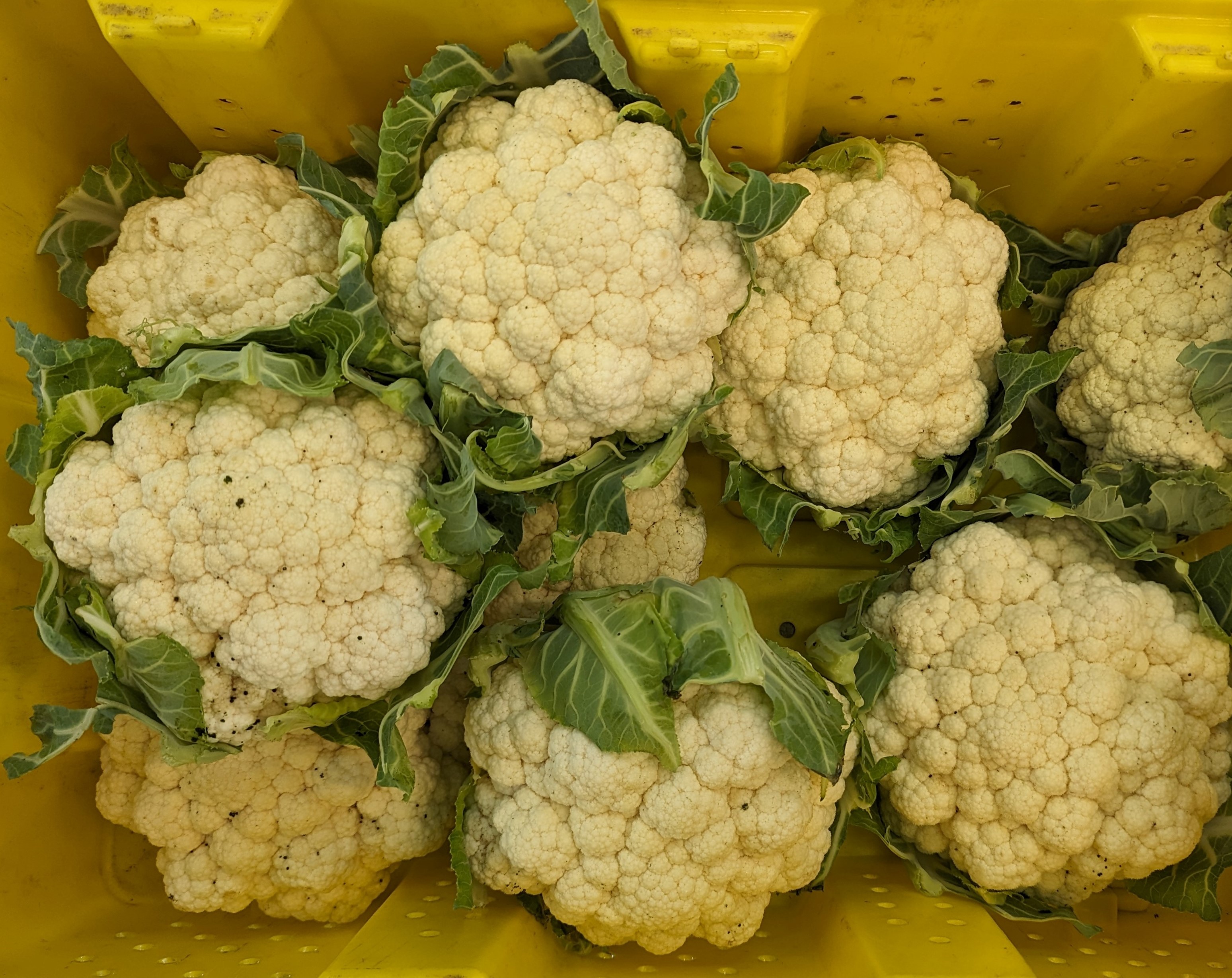
Cucurbits/pickles
Summer squash and cucumbers are being harvested. Melons are close to harvest, watermelons and hard squash are setting fruit. Mechanical harvest of pickles has begun.
We received reports of virus symptoms in squash this week. Here is a nice summary of different viruses in cucurbits from Meg McGrath at Cornell University. In most cases, viruses are prevented through insect management.
Stay on the lookout for cucurbit downy mildew and consider starting protectant fungicides on cucumbers, pickles and melons. Downy mildew sporangia that affect cucurbits have been detected by our early detection spore trapping system in the state. Each week on Thursday (late afternoon, early evening), the Hausbeck lab’s Downy Mildew News website is updated with the findings from the spore traps.
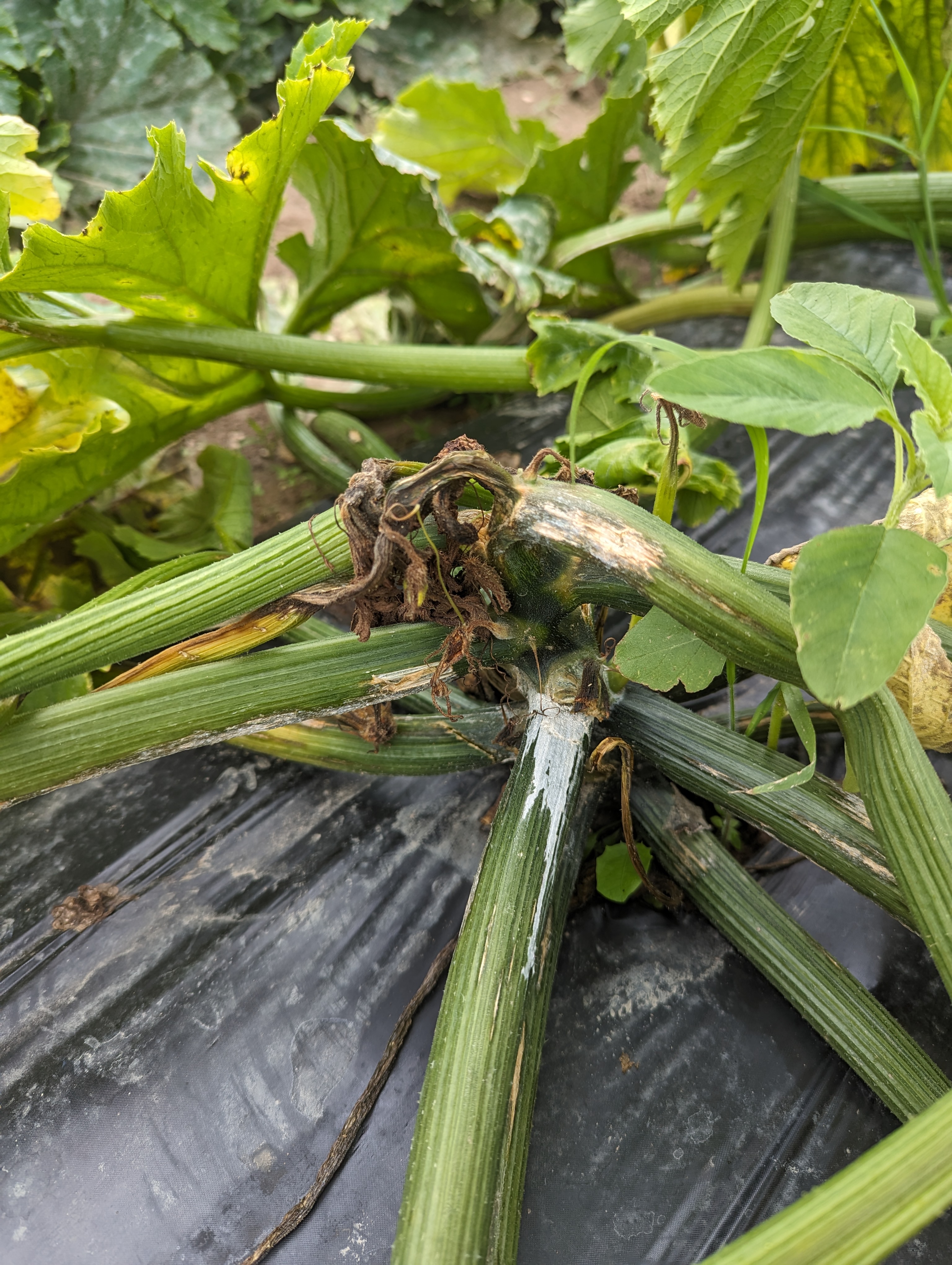
Since the rains began, Phytophthora has flared up in fields with a history of the disease. Phytophthora causing plant wilt and death for pepper, squash and zucchini has been reported across the state. The reports are not too surprising given the heavy rains that occurred across the state and the number of production sites with a history of contamination by this pathogen. This plant pathogen lives in the soil and survives Michigan winters. It does not move via air currents but spreads via splash of contaminated soil, surface water such as culverts, rivers, creeks and streams contaminated by run-off from infested fields, and/or the dumping of diseased culls onto production fields. Phytophthora is especially unique because it can develop a swimming spore when the soil becomes saturated. The swimming spores move across a field in a pattern consistent with draining water and kills plants in its path. Hausbeck has a fact sheet on Phytophthora and irrigation water. Squash, zucchini, pepper and pumpkin are especially susceptible. Plants that wilt and don’t recover can be a tell-tale symptom of this disease.
Squash and pumpkin offer special challenges because both the plant and fruit are susceptible to Phytophthora. To keep the plants alive, applications of fungicide through the drip is important and vastly more effective than overhead sprays to the foliage. In this way, the management of Phytophthora on pepper and squash/pumpkin is similar. However, keeping the squash and pumpkin plants alive is only part of the battle. The second part of the disease management battle for squash and pumpkin is keeping the fruit alive even though it may be in close contact with contaminated soil. While the drenches keep the plant alive, they cannot protect the fruit. Only foliar applications of fungicides can protect the fruit and the fungicide sprays must be made so that they reach the fruit directly. If the canopy is dense, the fungicide spray may not reach the fruit, leaving it unprotected. Some growers have made adjustments and decreased the plant density to ensure that their fungicide sprays are able to reach the fruit.
Recent studies from our lab shows that hard squash is especially susceptible within the first three weeks of development and illustrates that these young fruits may need more protection than previously thought. Mary Hausbeck has put together a factsheet for fungicide management recommendations for winter squash and pumpkin, and another one for fungicide management recommendations for summer squash and zucchini. MSU research has also shown that green zucchini plants are less susceptible to Phytophthora than yellow summer squash. Acorn is also especially susceptible to crown and root rot compared to spaghetti squash.
Choosing effective fungicides for Phytophthora is critical! Controlling this pathogen has been part of the MSU Hausbeck pathology lab’s field research for more than two decades. Keeping fungicide intervals tight and alternating effective products is especially important to remember this season.
MSU is looking for anthracnose leaf and fruit rot and Phytophthora samples for research. Please reach out to us if you’ve got any potential infestations.
Fruiting vegetables
Pepper harvest has begun on some farms. Conditions have been favorable for development of foliar fungal and bacterial diseases, and Phytophthora has flared up in some fields.
Symptoms of Phytophthora on pepper typically include wilting and are being observed in some fields. The strategies that are needed to protect pepper crops from Phytophthora root and crown rot include application of fungicides to the plant’s root/crown zone via drip. Years of MSU studies with pepper have shown the stark contrast between application of fungicides via drip versus a foliar application to the lower plant stem. In short, the plants receiving the fungicide through the drip lived, whereas the plants receiving a foliar application to the base of the stem mostly died. There was such a big difference between the ability of drenches to protect the plant versus foliar applications, that foliar applications cannot be recommended for pepper unless there is clear evidence of fruit rot.
In Michigan, there have been just a few instances of fruit rot occurring over the years, so the focus is entirely on keeping the plant healthy via fungicide drenches. There are some varieties of green bell peppers that have a good level of genetic resistance to Phytophthora. These cultivars are not immune from the disease, but they will stay healthy a lot longer than the varieties that do not have this resistance. Hausbeck has a fact sheet for fungicide management recommendations for Phytophthora on pepper.
Garlic
Garlic harvest has begun and some are noticing areas in the field with bulb rot symptoms. There are several possible causes including stem and bulb nematodes and Fusarium. Bulbs with questionable quality should be sorted out and certainly should not be used for seed. Symptomatic bulbs can be submitted to the MSU Plant & Pest Diagnostic lab for analysis. Crop rotation is especially important for situations where soil borne pathogens are confirmed.
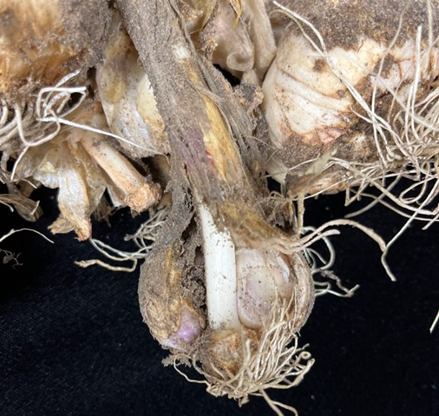
Onions
Stemphylium has advanced in locations it was noted in the past two weeks. Read Hausbeck’s trial-based info on Stemphylium spray programs. Bravo (FRAC M5) plus Tilt (FRAC 3) and Omega/Orvus (FRAC 29) are good options to include in rotation with FRAC 7 fungicides (e.g., MIravis Prime and the Luna products). Onion fields with significant amounts of herbicide damage may be more severely impacted by Stemphylium that appears to readily colonize the damaged tissue and then may expand into the healthy tissue causing large blighted areas and eventual leaf death.
Different farms have followed up Movento with different things for thrips. So… what to use for sprays 5 and 6? Check out Cornell’s spray program guide, it provides different sequences, based on thrips populations and what has been used earlier in the season. For example, Radiant or Exirel could be used following Agri-Mek. Radiant could be used after Minecto Pro.
Potatoes
White mold apothecia was found in central Michigan. Be mindful of late blight.
Sweet corn
Corn earworm captures have been low and variable to date. West central Michigan scouts did detect a very low percentage of caterpillars in ears, likely from eggs laid a few weeks back. Keep in mind that any non-zero trap catch during silking may justify treatment. Trap catches are most useful in gauging how frequently to spray (more moths equal tighter intervals), rather than whether or not to spray in the first place.
It is most useful to monitor your own trap, but you can also check trapping data to our south and monitor when conditions are ripe for migration. Here are some resources to bookmark:
Good coverage of silks is just as important as timing for earworm control. Growers may variously use high clearance booms sprayers without drops, booms with drops aimed at silks, airblast cannons or even aerial drones. It is a good idea to assess coverage with water sensitive paper if switching to a new application method. Read a past example here. It’s as simple as clipping a number of cards to the silk zone on ears. You can then run a pass with the old sprayer configuration/tech and water, evaluate coverage with the snapcard app, and make a second go with fresh cards and the new app method. Then compare, adjust and/or and make a decision.
Western bean cutworm moths may be flying at some locations. Females of this pest prefer to lay eggs on the top few leaves of corn just about to tassel. Caterpillars can then move to the ear to cause damage. Insecticide applications targeting corn earworm typically take care of this pest, but it could become a problem if timely applications are not made.
What to spray? Corn earworms can be managed with pyrethroid, diamide or spinosyn insecticides. Pyrethroids include Ambush/Pounce, Asana, Baythroid, Capture/Brigade, Hero, Mustang Maxx and Warrior. Diamides include chlorantraniliprole, which is in Besiege, Coragen and Vantacor. Spinosyns include spinetoram, or Radiant. In some places, pyrethroids have produced unsatisfactory results because of the development of resistance.
Strawberries
For many growers, it is time to renovate strawberries.
On-Farm Food Safety
MSU and the Conservation Districts offer a program to visit your farm to go over your food safety program to provide critiques and comfort in a confidential fashion. You can then use these notes to make changes ahead of an actual inspection from MDARD. If you are interested in an On-Farm Readiness Review, please fill out this OFRR request survey to start the scheduling process (the sooner the better).
Source : msu.edu